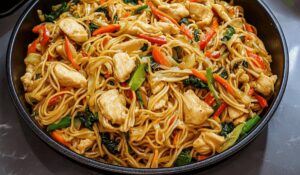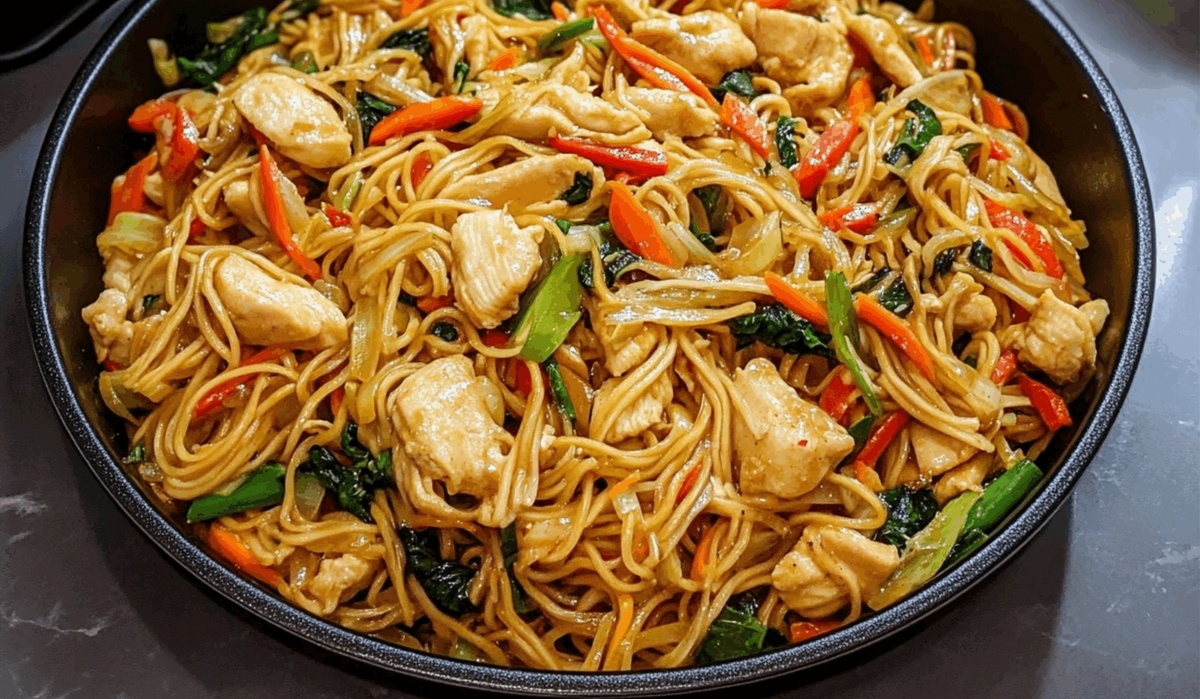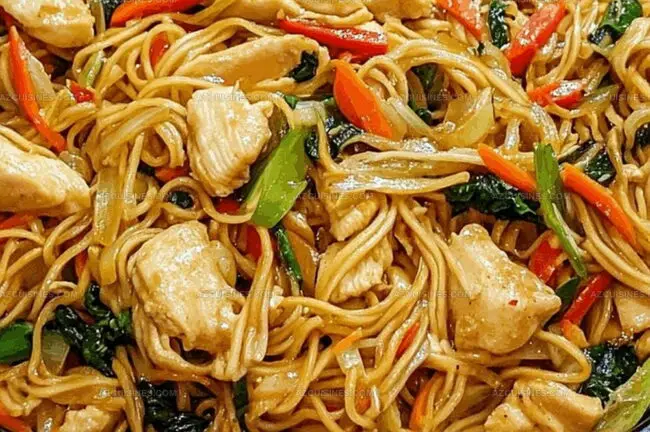Sizzling Chicken Chow Mein With The Best Sauce Recipe
Noodle enthusiasts will adore this chicken chow mein that brings authentic Chinese flavors directly to your kitchen.
Crispy vegetables and tender meat create a delightful dance of textures and tastes.
Home cooks appreciate how quickly this dish comes together with simple ingredients.
Each bite promises a perfect balance of savory and slightly sweet notes.
Skilled chefs know the secret lies in the incredible homemade sauce that elevates every strand of noodle.
Fresh ingredients make all the difference in creating a restaurant-quality meal you can whip up in minutes.
Give this recipe a try and watch your dinner table light up with excitement!
Why Chicken Chow Mein Is So Satisfying
What’s In Chicken Chow Mein
Protein Base:Noodle Component:Vegetable Medley:Aromatic Enhancers:Sauce Ingredients:Binding and Seasoning:Egg (Optional):Cooking Medium:How To Whip Up Chicken Chow Mein
Step 1: Prep The Chicken
Slice chicken breasts into thin, delicate strips that will cook quickly and evenly. Make sure each strip looks uniform for perfect cooking.
Step 2: Warm Up The Cooking Station
Heat vegetable oil in a large wok or skillet over high heat until it’s sizzling hot and ready for action.
Step 3: Cook Chicken To Golden Perfection
Toss chicken strips into the hot wok, stirring constantly for 3-4 minutes until they transform into a beautiful golden color and are fully cooked through. Remove and set aside.
Step 4: Awaken The Aromatics
In the same sizzling wok, quickly dance minced garlic and grated ginger for about 30 seconds to release their incredible fragrance.
Step 5: Veggie Dance Party
Toss in your colorful veggie lineup:Stir-fry these veggies for 2-3 minutes until they’re crisp and vibrant.
Step 6: Noodle Integration
Introduce fresh chow mein noodles to the vegetable mix, using tongs to separate and blend them smoothly.
Step 7: Create The Magic Sauce
Whisk together in a small bowl:Step 8: Sauce It Up
Pour the prepared sauce over the noodles and vegetables, tossing rapidly to ensure every strand gets coated with deliciousness.
Step 9: Bring It All Together
Return the cooked chicken strips to the wok, gently mixing to warm everything and create a harmonious blend of flavors.
Step 10: Garnish And Serve
Sprinkle chopped green onions over the top for a fresh, zesty finish. Serve immediately while piping hot to enjoy maximum flavor and texture.
Best Tips For Chicken Chow Mein Success
Tasty Changes For Chicken Chow Mein
Best Pairings For Chicken Chow Mein
How To Store Chicken Chow Mein The Smart Way
FAQs On Chicken Chow Mein Made Easy
Chow mein noodles are typically par-boiled wheat noodles that can be either crispy or soft, depending on cooking method. They have a distinct texture and absorb sauces more effectively than other noodle varieties.
Yes, frozen vegetables work well in chow mein. Just thaw and drain them completely before adding to the wok to prevent excess moisture from making the dish soggy.
While a wok provides the best heat distribution and creates authentic stir-fry results, a large skillet can work effectively. The key is using high heat and rapid cooking techniques.
Print
Chicken Chow Mein With The Best Chow Mein Sauce Recipe
- Total Time: 25 minutes
- Yield: 4 1x
Description
Sizzling chicken chow mein brings Chinese takeout magic right to home kitchens with its irresistible blend of tender noodles and savory sauce. Crisp vegetables and perfectly seasoned chicken create a quick, satisfying meal you’ll crave again and again.
Ingredients
Protein:
- 2 lbs chicken breast, boneless and skinless
- 1/2 cup egg (2–3 large eggs)
Noodles and Vegetables:
- 1 lb fresh chow mein noodles
- 2 cups shredded cabbage
- 1 cup carrots, julienned
- 1/2 cup green onions, chopped
- 1/4 cup celery, thinly sliced
Sauce and Seasonings:
- 1/4 cup soy sauce
- 2 tbsp oyster sauce
- 1 tbsp sesame oil
- 2 tbsp vegetable oil
- 2 cloves garlic, minced
- 1 tbsp ginger, freshly grated
- 1/2 tsp white pepper
- 1 tsp sugar
- 1/4 tsp salt
Instructions
- Slice chicken breasts into thin, uniform strips to ensure even cooking and quick heat absorption.
- Whisk eggs thoroughly in a separate bowl, preparing them for potential protein addition to the dish.
- Heat vegetable oil in a large wok or skillet over high heat until it shimmers and shows signs of extreme heat readiness.
- Rapidly sauté chicken strips, stirring continuously for 3-4 minutes until they turn golden and completely cooked through.
- Remove chicken and set aside, keeping the wok hot and ready for vegetables.
- In the same wok, quickly stir-fry minced garlic and grated ginger for 30 seconds to release their aromatic essence.
- Add julienned carrots, shredded cabbage, and sliced celery, tossing vigorously for 2-3 minutes until vegetables are crisp-tender.
- Introduce fresh chow mein noodles to the vegetable mixture, using tongs to separate and integrate them evenly.
- Combine soy sauce, oyster sauce, sesame oil, white pepper, sugar, and salt in a small bowl to create a harmonious sauce.
- Pour the prepared sauce over the noodle-vegetable mixture, tossing rapidly to ensure complete coating.
- Reintroduce cooked chicken strips, gently mixing to warm and incorporate all ingredients.
- Sprinkle chopped green onions over the top for a fresh, vibrant finish.
- Serve immediately while piping hot, ensuring optimal flavor and texture.
Notes
- Slice chicken uniformly to guarantee consistent cooking and prevent dry or undercooked sections.
- Opt for high-heat cooking to achieve that authentic wok-style caramelization and crisp vegetable texture.
- Consider protein swaps like tofu or shrimp for versatile dietary adaptations without compromising flavor profile.
- Use day-old refrigerated noodles to prevent soggy texture and help them absorb sauce more effectively during stir-frying.
- Prep Time: 15 minutes
- Cook Time: 10 minutes
- Category: Lunch, Dinner, Appetizer
- Method: Sautéing
- Cuisine: Chinese
Nutrition
- Serving Size: 4
- Calories: 600
- Sugar: 2 g
- Sodium: 800 mg
- Fat: 24 g
- Saturated Fat: 4 g
- Unsaturated Fat: 18 g
- Trans Fat: 0 g
- Carbohydrates: 70 g
- Fiber: 4 g
- Protein: 40 g
- Cholesterol: 120 mg




Truc Tran (Kris)
Senior Food Editor
Expertise
Home Cooking, Meal Planning, Recipe Development, Baking and Pastry, Food Editor, Cooking-video Maker, Vietnamese Food Evaluation Expert
Education
Truc Tran (Kris), an experienced food writer and editor, is great at exploring and describing global cuisines, from simple street food to fancy dining. In her writing, she skillfully mixes different flavors, cooking methods, and culinary traditions, showing the unique character of various cultures through their food and drinks. On azcuisines.com, Kris highlights her knowledge, especially in Asian cuisine and worldwide traditional dishes.